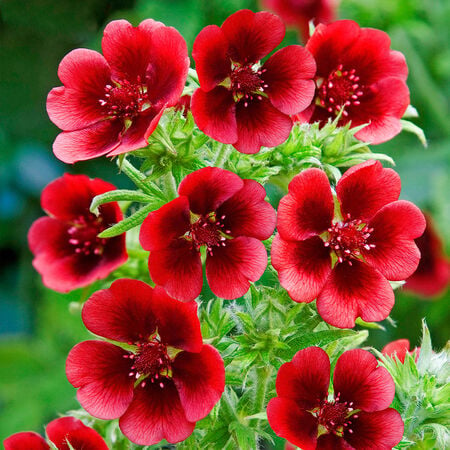Monarch's Velvet, Potentilla Seeds
Key Attributes
Key Attributes
Product Details
Weight
0.01Depth
0.15Height
4.5Width
3.25Plant Height
12-30"Botanical Name
Potentilla thunberiSeed Type
SeedPacket
50 SeedsSow Depth
1/16"Breed
Open-pollinatedSun
Full Sun / Partial ShadeLife Cycle
PerennialSow Method
TransplantCategories
FlowersDays To Maturity (# Days)
90Components
Growing Instructions
![]() Learning Download: How to Grow Potentilla
Learning Download: How to Grow Potentilla
Potentilla is a native shrub that is small and rounded. This shrub will attract beneficial insects to the garden, and it’s also deer resistant. The blooms are buttercup-like, and the leaves are small and finely textured which gives the shrub a delicate appearance.
Before Planting: Prior to planting, make sure you amend the soil with compost.
Planting: Direct sow after your last spring frost.
Watering: Potentilla is drought resistant but likes moisture. Water during prolonged dry spells.
Fertilizer: Fertilize in the spring with a layer of compost and an organic plant food.
Days to Maturity: Potentilla will bloom from midsummer to when the frost comes.
Harvesting: Since it resembles a shrub, Potentilla isn’t a harvestable plant.
Tips: Potentilla will continue to grow year after year. however, following winter, there may be some dieback in the plant. Each spring, prune out any dead or diseased branches. Throughout the summer, continue to prune to help shape the plant.
Shipping Schedule
Our Seed Promise
 "Agriculture and seeds" provide the basis upon which our lives depend. We must protect this foundation as a safe and genetically stable source for future generations. For the benefit of all farmers, gardeners and consumers who want an alternative, we pledge that we do not knowingly buy or sell genetically engineered seeds or plants.
"Agriculture and seeds" provide the basis upon which our lives depend. We must protect this foundation as a safe and genetically stable source for future generations. For the benefit of all farmers, gardeners and consumers who want an alternative, we pledge that we do not knowingly buy or sell genetically engineered seeds or plants.
The mechanical transfer of genetic material outside of natural reproductive methods and between genera, families or kingdoms, poses great biological risks as well as economic, political, and cultural threats. We feel that genetically engineered varieties have been insufficiently tested prior to public release. More research and testing is necessary to further assess the potential risks of genetically engineered seeds. Further, we wish to support agricultural progress that leads to healthier soils, to genetically diverse agricultural ecosystems, and ultimately to healthy people and communities.
To learn more about the "Safe Seed Pledge" please visit www.councilforresponsiblegenetics.org.

